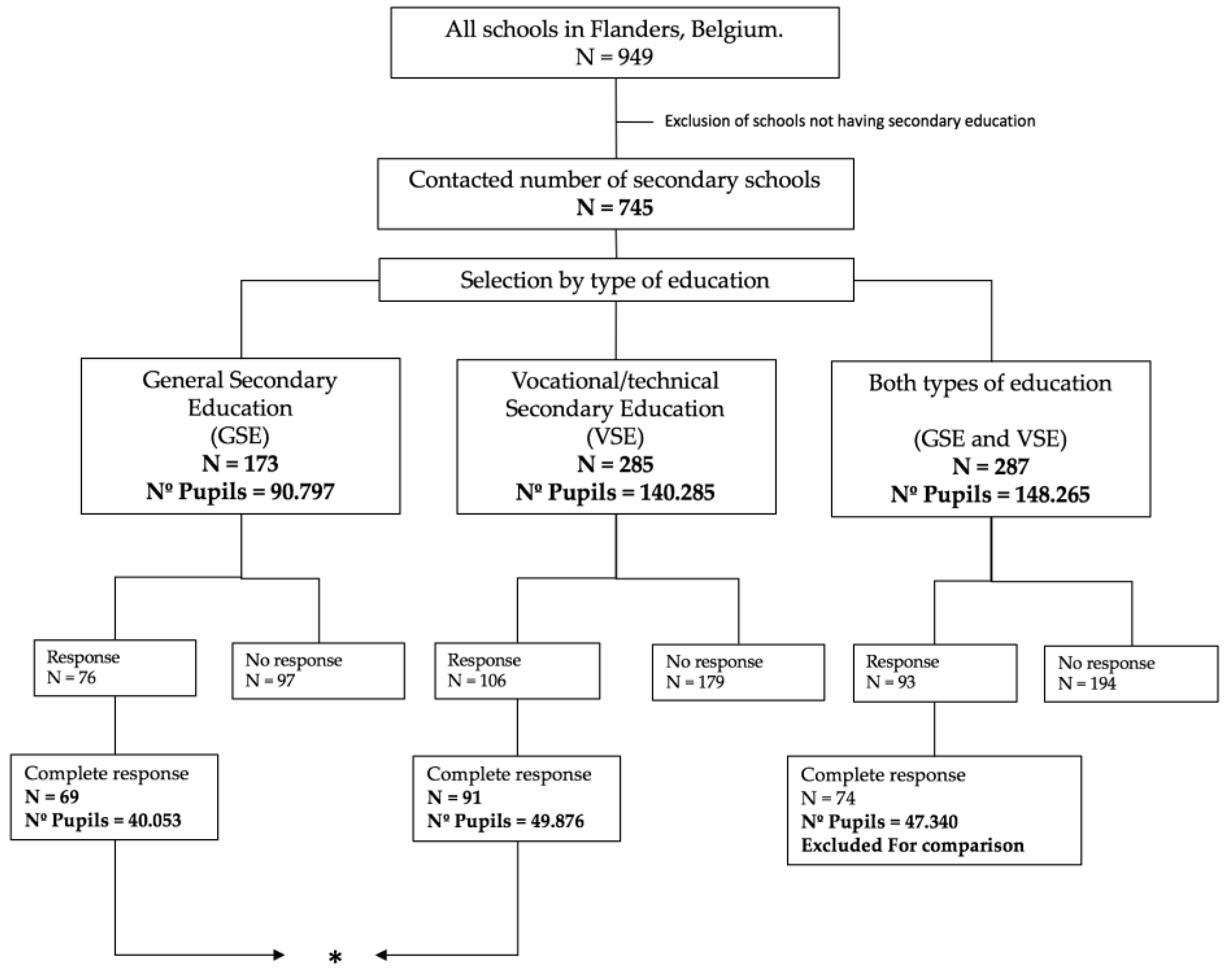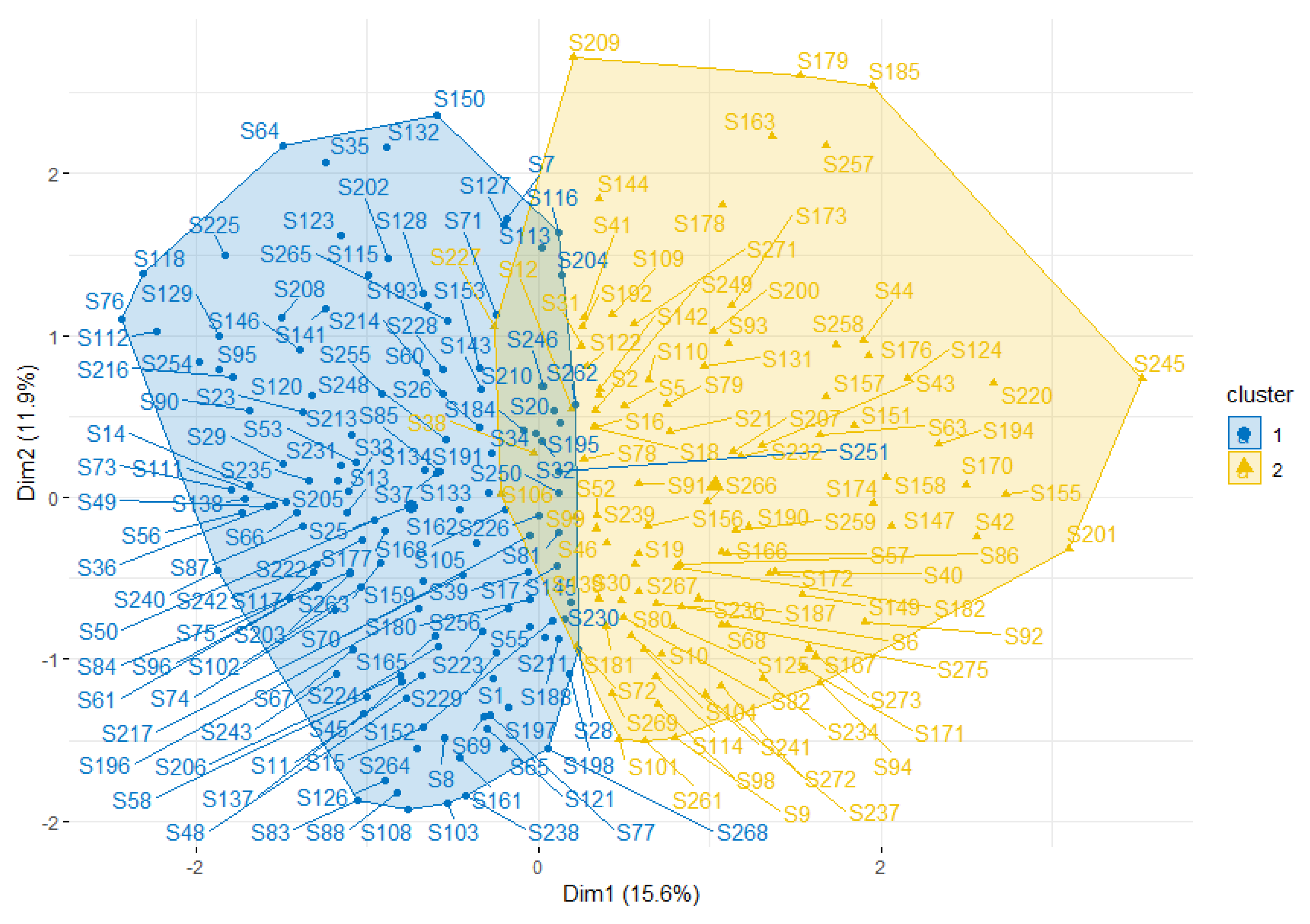School Food Policies Related to Soft Drink and Fruit Juice Consumption as a Function of Education Type in Flanders, Belgium
Abstract
1. Introduction
2. Materials and Methods
2.1. Sample Selection and Ethical Aspects
2.2. Data Management and Statistical Analysis
3. Results
3.1. Descriptive Statistics
3.2. SES Differences between Schools
3.3. School Food Policies Related to Soft Drinks and Fruit Juices
3.4. Access Times and Availability of Soft Drinks and Fruit Juices
3.5. Water Access and Promotion of Healthy Drinking Habits
4. Discussion
5. Conclusions
Author Contributions
Funding
Acknowledgments
Conflicts of Interest
References
- Kubik, M.Y.; Lytle, L.A.; Hannan, P.J.; Perry, C.L.; Story, M. The association of the school food environment with dietary behaviors of young adolescents. Am. J. Public Health 2003, 93, 1168–1173. [Google Scholar] [CrossRef] [PubMed]
- Velazquez, C.E.; Black, J.L.; Potvin Kent, M. Food and Beverage Marketing in Schools: A Review of the Evidence. Int. J. Environ. Res. Public Health 2017, 14, 1054. [Google Scholar] [CrossRef] [PubMed]
- World Health Organization. Set of Recommendations on the Marketing of Foods and Non-Alcoholic Beverages to Children; WHO: Geneva, Switzerland, 2010; Available online: https://www.who.int/dietphysicalactivity/marketing-food-to-children/en/ (accessed on 14 May 2019).
- Storcksdieck, G.B.S.; Kardakis, T.; Wollgast, J.; Nelson, M.; Caldeira, S. Mapping of national school food policies across the EU28 plus Norway and Switzerland. In JRC Science and Policy Reports; European Commision: Publications office of the European Union, Luxembourg, Luxembourg, 2014; Available online: http://publications.jrc.ec.europa.eu/repository/bitstream/JRC90452/lbna26651enn.pdf (accessed on 14 May 2019).
- American Academy of Pediatrics Committee on School Health. Soft Drinks in Schools; American Academy of Pediatrics: Itasca, IL, USA, 2004; Volume 113. [Google Scholar]
- Jaeggi, T.; Lussi, A. Prevalence, incidence and distribution of erosion. Monogr. Oral Sci. 2014, 25, 55–73. [Google Scholar] [PubMed]
- Lussi, A.; Carvalho, T.S. Erosive tooth wear: A multifactorial condition of growing concern and increasing knowledge. Monogr. Oral Sci 2014, 25, 1–15. [Google Scholar] [PubMed]
- Bartlett, D. A personal perspective and update on erosive tooth wear-10 years on: Part 1—Diagnosis and prevention. Br. Dent. J. 2016, 221, 115–119. [Google Scholar] [CrossRef] [PubMed]
- Schlueter, N.; Tveit, A.B. Prevalence of erosive tooth wear in risk groups. Monogr. Oral Sci. 2014, 25, 74–98. [Google Scholar] [PubMed]
- Bartlett, D.W.; Lussi, A.; West, N.X.; Bouchard, P.; Sanz, M.; Bourgeois, D. Prevalence of tooth wear on buccal and lingual surfaces and possible risk factors in young European adults. J. Dent. 2013, 41, 1007–1013. [Google Scholar] [CrossRef] [PubMed]
- Marro, F.; Jacquet, W.; Bottenberg, P.; Martens, L. The Influence of Behavioural and Sociodemographic Risk Indicators on Erosive Tooth Wear in Flemish Adolescents, Belgium. Caries Res. 2018, 52, 119–128. [Google Scholar] [CrossRef]
- Milosevic, A.; Bardsley, P.F.; Taylor, S. Epidemiological studies of tooth wear and dental erosion in 14-year old children in North West England. Part 2: The association of diet and habits. Br. Dent. J. 2004, 197, 479–483. [Google Scholar] [CrossRef]
- Mulic, A.; Skudutyte-Rysstad, R.; Tveit, A.B.; Skaare, A.B. Risk indicators for dental erosive wear among 18-yr-old subjects in Oslo, Norway. Eur. J. Oral Sci. 2012, 120, 531–538. [Google Scholar] [CrossRef]
- Vereecken, C.A.; Bobelijn, K.; Maes, L. School food policy at primary and secondary schools in Belgium-Flanders: Does it influence young people’s food habits? Eur. J. Clin. Nutr. 2005, 59, 271–277. [Google Scholar] [CrossRef]
- Vereecken, C.; van Houte, H.; Martens, V.; Wittebroodt, I.; Maes, L. Parents’ and teachers’ opinions about the school food policy in Belgian Flemish nursery schools. Int. J. Environ. Res. Public Health 2009, 6, 1268–1281. [Google Scholar] [CrossRef] [PubMed]
- Verzeletti, C.; Maes, L.; Santinello, M.; Vereecken, C.A. Soft drink consumption in adolescence: Associations with food-related lifestyles and family rules in Belgium Flanders and the Veneto Region of Italy. Eur. J. Public Health 2010, 20, 312–317. [Google Scholar] [CrossRef] [PubMed]
- UNESDA. Union of European Union Soft Drinks Associations. Available online: http://www.unesda.eu/products-ingredients/consumption/ (accessed on 14 May 2019).
- Reynders, T.; Nicaise, I.; Van Damme, J. De Constructie van SES-Variabele voor Het SiBO-Onderzoek. Available online: http://www.informatieportaalssl.be/SiBO-Databank/_Hoofdtabellen/LOA-RAPPORT31_ConstructieSES.pdf (accessed on 29 July 2019).
- Bornstein, M.H.; Hahn, C.; Suwalsky, J.T.D.; Haynes, M.O. The Hollingshead Four-Factor Index of Social Status and the Socioeconomic Index of Occupations. In Socioeconomic Status, Parenting and Child Development; Lawrence Elrbaum Associates: Mahwah, NJ, USA, 2003. [Google Scholar]
- R Core Team. R: A Language and Environment for Statistical Computing; R Foundation for Statistical Computing: Vienna, Austria, 2018. [Google Scholar]
- Bécue-Bertaut, M.; Pagès, J. Multiple factor analysis and clustering of a mixture of quantitative, categorical and frequency data. Comput. Stat. Data Anal. 2008, 52, 3255–3268. [Google Scholar] [CrossRef]
- World Health Organization. Global Strategy on Diet, Physical Activity & Health. The Role of the Schools. Available online: https://www.who.int/dietphysicalactivity/childhood_schools/en/ (accessed on 25 July 2019).
- Onderwijsaanbod in Vlaanderen. 2019. Available online: https://data-onderwijs.vlaanderen.be/onderwijsaanbod/ (accessed on 14 May 2019).
- Vereecken, C.A.; Maes, L.; De Bacquer, D. The influence of parental occupation and the pupils’ educational level on lifestyle behaviors among adolescents in Belgium. J. Adolesc. Health 2004, 34, 330–338. [Google Scholar] [CrossRef]
- Ludwig, D.S.; Peterson, K.E.; Gortmaker, S.L. Relation between consumption of sugar-sweetened drinks and childhood obesity: A prospective, observational analysis. Lancet 2001, 357, 505–508. [Google Scholar] [CrossRef]
- Zhang, S.; Chau, A.M.; Lo, E.C.; Chu, C.H. Dental caries and erosion status of 12-year-old Hong Kong children. BMC Public Health 2014, 14, 7. [Google Scholar] [CrossRef] [PubMed]
- Larsen, M.J.; Nyvad, B. Enamel erosion by some soft drinks and orange juices relative to their pH, buffering effect and contents of calcium phosphate. Caries Res. 1999, 33, 81–87. [Google Scholar] [CrossRef] [PubMed]


| All Schools in BE-F n = 745 | Participating Schools n = 234 | |||
|---|---|---|---|---|
| n (%) | Proportion of low-educated mothers | n (%) | Proportion of low-educated mothers | |
| GSE | 173 (23.09%) | 13.32% | 69 (29.5%) | 12.04% |
| VSE | 285 (38.05%) | 32.9% | 91 (38.9%) | 30.07% |
| Total (n:234) | GSE (n = 69) General Education | VSE (n = 91) Vocational/Technical Education | p-Value | |
|---|---|---|---|---|
| The school has written SFP related to the consumption of soft drinks. | 44.0% (103) | 40.6% (28) | 39.7% (36) | 0.896 |
| The school has written SFP related to the consumption of fruit juices. | 24.4% (57) | 27.5% (19) | 14.4% (14) | 0.06 |
| The school prohibits the consumption of soft drinks and/or fruit juices. | 13.2% (31) | 18.8% (13) | 7.7% (7) | 0.035 * |
| The school limits the consumption of soft drinks and/or fruit juices. | 55.1% (129) | 65.2% (45) | 46.2% (42) | 0.017 * |
| The school allows students to bring their own soft drinks and/ or fruit juices. | 85.9% (201) | 76.8% (53) | 87.9% (80) | 0.063 |
| The school allows sale of soft drinks and/or fruit juices to the students | 65.0% (152) | 65.2% (45) | 71.4% (65) | 0.401 |
| The school benefits financially from the sale of soft drinks and/or fruit juices at school. | 44.0% (103) | 46.4% (32) | 47.6% (43) | 0.912 |
| It is a problem to abandon this sale. | 12.8% (30) | 14.5% (10) | 13.2% (12) | 0.812 |
© 2019 by the authors. Licensee MDPI, Basel, Switzerland. This article is an open access article distributed under the terms and conditions of the Creative Commons Attribution (CC BY) license (http://creativecommons.org/licenses/by/4.0/).
Share and Cite
Marro, F.; Bottenberg, P.; Jacquet, W.; Martens, L. School Food Policies Related to Soft Drink and Fruit Juice Consumption as a Function of Education Type in Flanders, Belgium. Int. J. Environ. Res. Public Health 2019, 16, 2718. https://doi.org/10.3390/ijerph16152718
Marro F, Bottenberg P, Jacquet W, Martens L. School Food Policies Related to Soft Drink and Fruit Juice Consumption as a Function of Education Type in Flanders, Belgium. International Journal of Environmental Research and Public Health. 2019; 16(15):2718. https://doi.org/10.3390/ijerph16152718
Chicago/Turabian StyleMarro, Francisca, Peter Bottenberg, Wolfgang Jacquet, and Luc Martens. 2019. "School Food Policies Related to Soft Drink and Fruit Juice Consumption as a Function of Education Type in Flanders, Belgium" International Journal of Environmental Research and Public Health 16, no. 15: 2718. https://doi.org/10.3390/ijerph16152718
APA StyleMarro, F., Bottenberg, P., Jacquet, W., & Martens, L. (2019). School Food Policies Related to Soft Drink and Fruit Juice Consumption as a Function of Education Type in Flanders, Belgium. International Journal of Environmental Research and Public Health, 16(15), 2718. https://doi.org/10.3390/ijerph16152718




